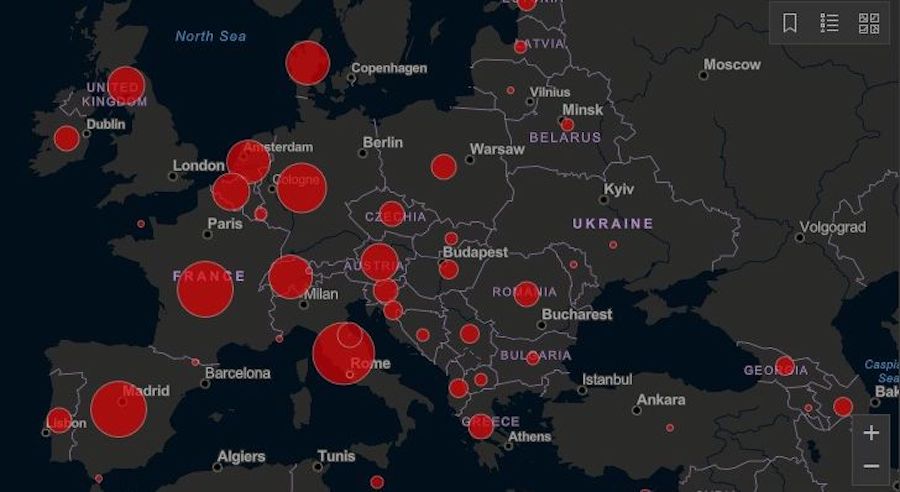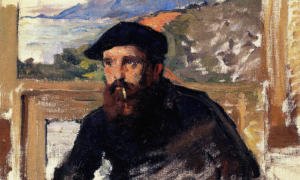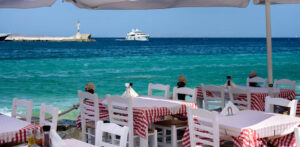(Editor’s note: We’re closing out this post for two reasons. The first is, most countries in Europe are recovering swiftly from the COVID-19 pandemic. The second is, it’s increasingly apparent no agency has reliable data documenting how many coronavirus-related infections and deaths there are. Much of the reporting by individual countries is misleading, with deaths wildly underreported. Please see our new post here tracking pandemic rules and restrictions across Europe, which is updated daily. )
In the six weeks since the coronavirus pandemic started to disrupt life in Europe, the only certainty is uncertainty. No one can say exactly where COVID-19 originated. No one can say with any certainty who’s most at risk of falling seriously ill with COVID-19, though it seems to be people over 65-year-old. No one can say if reinfection is possible. And no one knows how many people are infected or have died.
The Wall Street Journal has an excellent analysis piece presenting evidence from new findings that the actual death toll across Europe might be far higher than reported.
From that post:
Newly published figures show deaths linked to the new coronavirus in the U.K. have far exceeded preliminary estimates, adding to a growing body of evidence across Europe that closely watched daily death tallies don’t reveal the virus’s true toll.
So, our numbers and everyone else’s are flawed to say the least. But we try to aggregate the most accurate data from Johns Hopkins’ Cornavirus Resource Center in Baltimore and other sources.
We’d note accurate mortality rate estimates are impossible without knowing the actual number of people infected, which no one does because testing is uneven. Complicating matters further, it’s likely the majority of people infected with COVID-19 show few or no symptoms.
All that aside, by all accounts, Europe’s expat centers are seeing improving trend lines, with slowing rates of infection and deaths in 24-hour periods. Governments are plotting gradual re-openings, and even workers in Spain are back on the job. Austria’s and Denmark’s trends are so favorable that the countries’ leaders have begun the reopening and German officials are plotting a gradual return to normal. On 4 April, Luxembourg was the first expat center since 26 March to go 24 hours without recording any coronavirus-related deaths.
But as of mid-April, some countries seem far from recovery, with France extending its lockdown until 19 May.
The good news is, unlike the United States and its short-term approach, France and other European Union countries are spending trillions of euros to make sure companies don’t close and workers lose their job in the event that the epidemic takes months, rather than weeks, to contain, according to the New York Times. The German government is rolling out an economic rescue package worth up to 750 billion euros, one of the most ambitious in the world, according to CNN. Germany also is assisting countries including France.
As of 2 April, 400,000 French companies had applied for aid to cover 4 million employees, or around 20-percent of the private-sector workforce.
As China, South Korea and other Asian countries emerge from the coronavirus pandemic, it remains a very dynamic environment in Europe, with 1,150,210 confirmed cases as of 20 April, up an aggregate 1,718 percent from 63,268 on 17 March and 103,615 deaths, up an aggregate 3,661 percent from 2,755 on 17 March, according to the World Health Organization. Basically, the number of cases increased seven fold in a mo nth and deaths in the United Kingdom and other countries have started climbing rapidly.
On 1 April, the world passed a grim milestone – 1 million COVID-19 cases, with about half of those in Europe. Now the global total is about 2 .5 million, again with half in Europe.
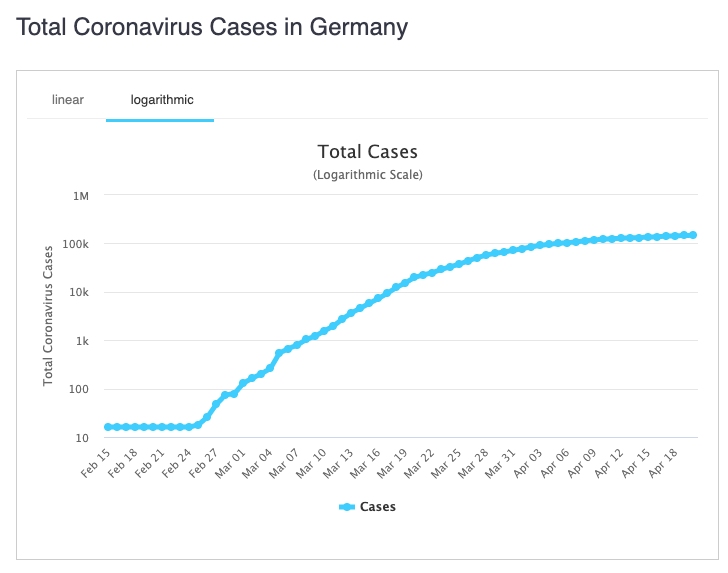
Basically, there are two Europes in the Pandemic of 2020 – countries such as the United Kingdom, France, Italy and Spain with full-blown crises and countries such as Austria , Estonia and Denmark that are – so far – relatively unaffected. A few countries still have zero recorded deaths, but aren’t on our list because they don’t have significant expat populations.
The European Union and the Schengen Zone are on lockdown until at least the end of April and likely into June.
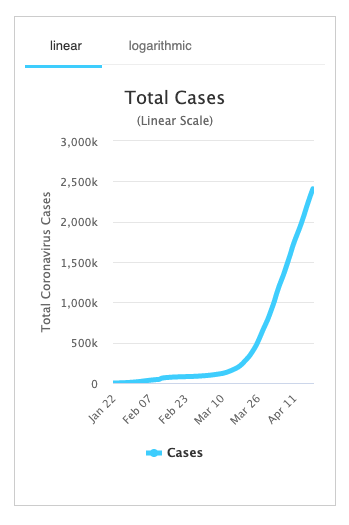
For the latest data, access the Johns Hopkins Coronavirus Resource Center and Worldometer, a website that aggregates various data from population figures to environmental data. The site has a running coronavirus infection, death and survival page you can see here.
And though we’re not doctors, we do see a trend in the data of survivors exceeding deaths in countries such as Spain. Worldometer shows more four times as many recovering patients as deaths worldwide.
What’s amazing is the exponential speed at which the coronavirus has swept the planet from late January to early March, which you can see at right in this chart from Worldometer.
Finally, Estonian expat Anna Bubnova is in South Korean for her overseas semester through Fontys University in Eindhoven. Anna is sending us posts about the differences between the Korean approach and European, with the Koreans relying far more on technology to monitor contagion. “The second there’s a case discovered, everyone in the area gets a notification on their phones,” Anna reports.
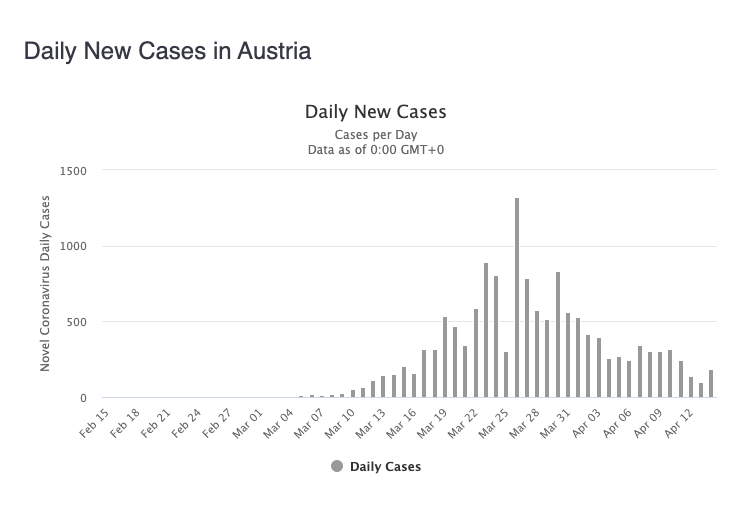
Austria
Austria crossed the 10,000-cases threshold on 31 March. But as of 3 April, Austrian officials are planning a return to normal, with the rate of new infections slowing daily. Small shops could open as of mid-April and tourists from Germany might be welcome back as early as this summer.
There are multiple theories that coronavirus took hold in Europe after an outbreak at Ischgl ski resort in Austria, according to the New York Times and other media outlets. On 26 March, Austria extended a shutdown of the resorts to at least mid-April, essentially ending the ski season.
Austria didn’t fool around, the first country in Europe to make face masks compulsory to enter supermarkets. With tough restrictions, data indicated Austria is past the worst, with infections dropping by 900 percent to 78 on 19 April from a peak of 1,321 on 26 March.
On 19 April, Austria reported only 78 new cases in 24 hours, the lowest number since 11 March.
On 8 April, the country reported its largest number of deaths in one day, 30, but deaths in 24 hours dropped to 9 by 19 April.
Austria set up five regional coronavirus clinics, with the states taking the lead in organization, and the Alpine country also plans to ramp up testing to 15,000 people per day having already tested about 50,000, according to the Voice of America.
Medical experts credit aggressive testing for Austria’s relatively low death rate.
Earlier, Austria closed its border with Italy. Italians can only enter Austria with documentation proving they don’t have coronavirus. Austrians returning from Italy are required to self-isolate for two weeks. The country has banned gatherings of more than five people, using police to enforce new regulations. Those restrictions are now extended to 13 April.
All of the country’s federal museums are closed. Austria is creating a 4 billion euro crisis fund.
•••••
The government has advised there are only four reasons to leave the house:
• You are one of the essential service workers (medical, supermarket, pharmacy, emergency repairs or similar).
• You have to get groceries or sustenance.
• You are caring for an elderly person or someone who needs support from others.
• You have to take our your dog or have a walk. But only if you maintain the necessary distance from other people.
– Ivana Avramovic in Vienna
(Editor’s note: You can see her full post here.)
Number of reported cases: 14,795, up an aggregate 2,159 percent from 655 on 14 March
Number of deaths: 470, up an aggregate of 2,838 percent from 16 on 22 March
Number of patients recovered: 10,631, up from 9 on 26 March
Belgium
Belgium went from about 200 confirmed cases on 8 March to almost 40,000 as of 19 April and is still having spikes of new cases and deaths. The country recorded the most deaths in 24 hours on 10 April at 496 deaths, 20 percent above the previous high of 403 on 7 April. Then deaths spiked again on 16 April at 417, the second-highest total.
Daily new cases hit 1,850 on 28 March, a record that held until 15 April when Belgium recorded 2,454 cases. Now the little country has the dismal distinction of having the most COVID-19 deaths per million in population at 503, now far higher than Spain (446) and Italy (391).
The Belgians are pushing to test 10,000 people per day, which means the number of infections likely will keep rising. Because of this uneven recovery, Belgian officials have extended the shutdown until 3 May from 19 April.
At the end of March, Belgium imposed a nation-wide lockdown decree and start closing its borders to all non-essential travel. That said, Dispatches staffers checked the Netherlands/Belgium border crossing near our headquarters of Eindhoven and it was open with normal traffic.
The Dutch “whatever” approach has not pleased the Belgians, with Brussels blaming cross-border travel for increased infections. “In the Netherlands, shops are still open and meetings of 100 people are still allowed — these are breeding grounds [for the virus],” Marino Keulen, mayor of the Belgian border town Lanaken, is quoted as saying by Politico.
Belgian Prime Minister Sophie Wilmes said people should only go out in case of emergency or to supermarkets, pharmacies or doctors. Gatherings and meetings are prohibited, according the Deutsche Welle.
All recreational activities are canceled, with restaurants and bars closing. Shops will close on weekends except for pharmacies and grocery stores.
Belgian officials already had suspended classes through mid-April including the Easter holidays (though schools will remain open) and Belgians had been asked to work from home, according to Politico.
All in all, Belgium’s approach is ranked as one of the more effective in Europe. Still, cases continue to rise, with Belgium’s health minister stating the peak lies ahead.
Number of reported cases: 39,983, up an aggregate 5,745 percent from 684 on 14 March
Number of deaths: 5,828, up an aggregate 145,600 percent from four on 14 March
Patients recovered: about 8,900, one of the better outcomes in terms of a percentage of confirmed cases.

Denmark
The Danes already are lifting coronavirus restrictions and schools are back open. Those restrictions were only put into place early – on 11 March – but have yielded results. Prime Minister Mette Frederiksen said infection rates have slowed to the point her country can at least start to plot a gradual return to normal including opening schools.
And of course, just as Frederiksen said that, Denmark posted what was then the highest number of coronavirus deaths on 4 April at 22, then posted the highest number of cases in a 24-hour period, 390, on 7 April, up from 312 the previous 24-hours. On 19 April, Denmark dropped to 142 daily new cases, the lowest number since late March, and 9 deaths, the lowest figure since 6 April.
Denmark’s biggest problem right now is its proximity to Sweden, which has done pretty much nothing in the way of implementing guidelines to stop the spread of COVID-19. Which is starting to cause some friction.
Denmark addressed the pandemic earlier than most countries in Europe, closing all schools and universities on 13 March and started sending home public-sector employees with “non-critical jobs,” according to news reports. It also banned gatherings of more than 10 people. Then, it closed its borders to all non-resident foreigns until 13 April. Only returning Danish citizens and documented residents of Denmark will be allowed into the country, according to Forbes.
Denmark is now famous for taking only 24 hours to craft and approve Europe’s biggest rescue package. The government will pay 75 percent of salaries at pandemic-hit companies to avoid mass layoffs. It’s also celebrated as the country that “perfected the art of the lockdown.”
Number of reported cases: 7,515 as of 19 April, up an aggregate of 800 percent from 836 on 14 March
Number of deaths 364, up from 1 on 14 March
Number of patients recovered: 4,312, up from 41 on 26 March


